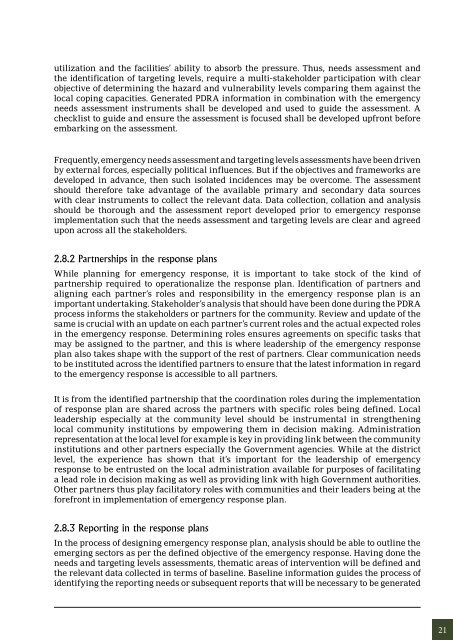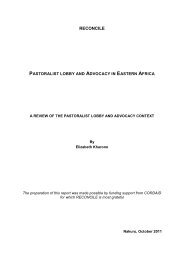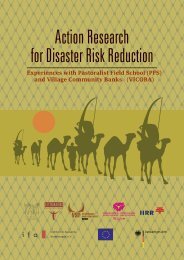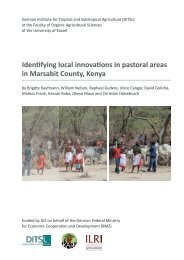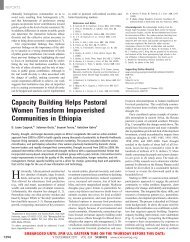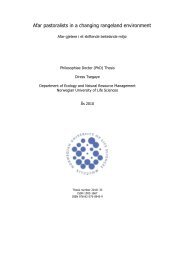Drought Contingency Planning with Pastoral Communities - celep
Drought Contingency Planning with Pastoral Communities - celep
Drought Contingency Planning with Pastoral Communities - celep
Create successful ePaper yourself
Turn your PDF publications into a flip-book with our unique Google optimized e-Paper software.
utilization and the facilities’ ability to absorb the pressure. Thus, needs assessment and<br />
the identification of targeting levels, require a multi-stakeholder participation <strong>with</strong> clear<br />
objective of determining the hazard and vulnerability levels comparing them against the<br />
local coping capacities. Generated PDRA information in combination <strong>with</strong> the emergency<br />
needs assessment instruments shall be developed and used to guide the assessment. A<br />
checklist to guide and ensure the assessment is focused shall be developed upfront before<br />
embarking on the assessment.<br />
Frequently, emergency needs assessment and targeting levels assessments have been driven<br />
by external forces, especially political influences. But if the objectives and frameworks are<br />
developed in advance, then such isolated incidences may be overcome. The assessment<br />
should therefore take advantage of the available primary and secondary data sources<br />
<strong>with</strong> clear instruments to collect the relevant data. Data collection, collation and analysis<br />
should be thorough and the assessment report developed prior to emergency response<br />
implementation such that the needs assessment and targeting levels are clear and agreed<br />
upon across all the stakeholders.<br />
2.8.2 Partnerships in the response plans<br />
While planning for emergency response, it is important to take stock of the kind of<br />
partnership required to operationalize the response plan. Identification of partners and<br />
aligning each partner’s roles and responsibility in the emergency response plan is an<br />
important undertaking. Stakeholder’s analysis that should have been done during the PDRA<br />
process informs the stakeholders or partners for the community. Review and update of the<br />
same is crucial <strong>with</strong> an update on each partner’s current roles and the actual expected roles<br />
in the emergency response. Determining roles ensures agreements on specific tasks that<br />
may be assigned to the partner, and this is where leadership of the emergency response<br />
plan also takes shape <strong>with</strong> the support of the rest of partners. Clear communication needs<br />
to be instituted across the identified partners to ensure that the latest information in regard<br />
to the emergency response is accessible to all partners.<br />
It is from the identified partnership that the coordination roles during the implementation<br />
of response plan are shared across the partners <strong>with</strong> specific roles being defined. Local<br />
leadership especially at the community level should be instrumental in strengthening<br />
local community institutions by empowering them in decision making. Administration<br />
representation at the local level for example is key in providing link between the community<br />
institutions and other partners especially the Government agencies. While at the district<br />
level, the experience has shown that it’s important for the leadership of emergency<br />
response to be entrusted on the local administration available for purposes of facilitating<br />
a lead role in decision making as well as providing link <strong>with</strong> high Government authorities.<br />
Other partners thus play facilitatory roles <strong>with</strong> communities and their leaders being at the<br />
forefront in implementation of emergency response plan.<br />
2.8.3 Reporting in the response plans<br />
In the process of designing emergency response plan, analysis should be able to outline the<br />
emerging sectors as per the defined objective of the emergency response. Having done the<br />
needs and targeting levels assessments, thematic areas of intervention will be defined and<br />
the relevant data collected in terms of baseline. Baseline information guides the process of<br />
identifying the reporting needs or subsequent reports that will be necessary to be generated<br />
21


